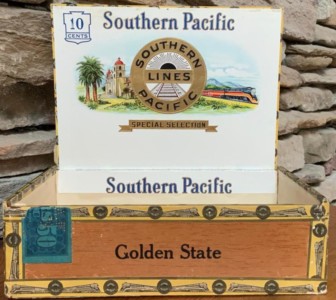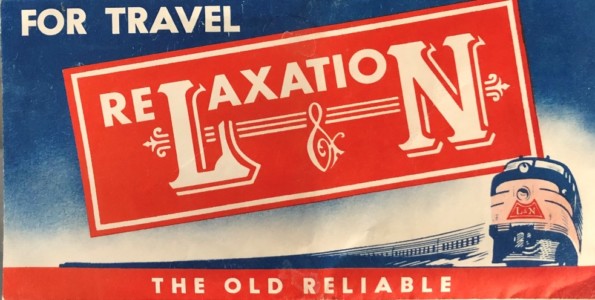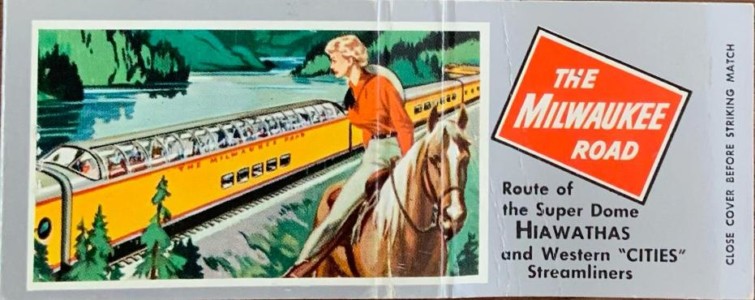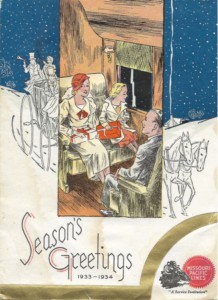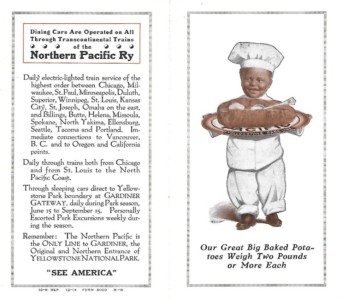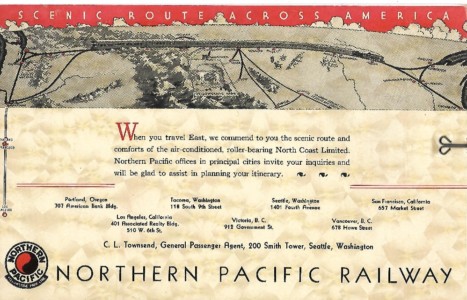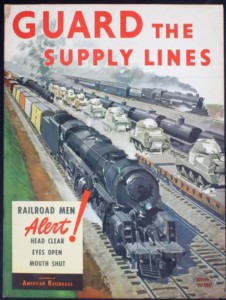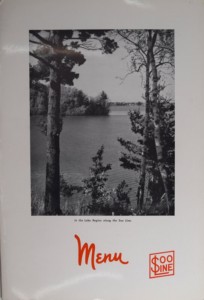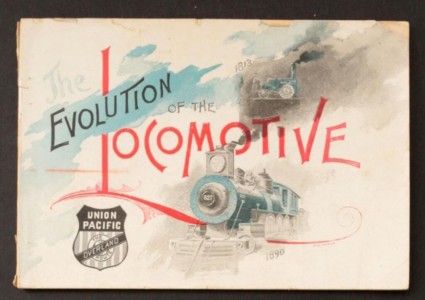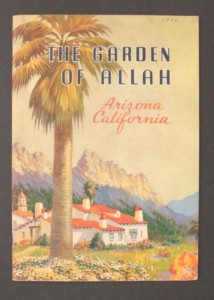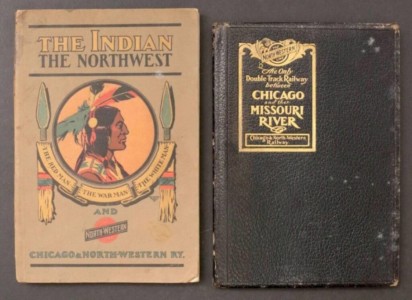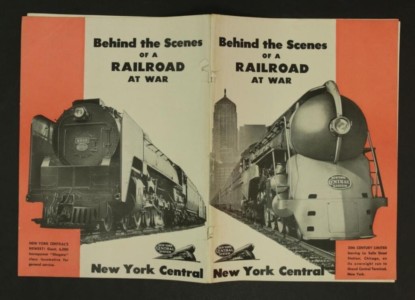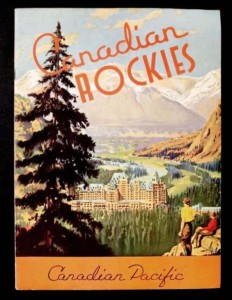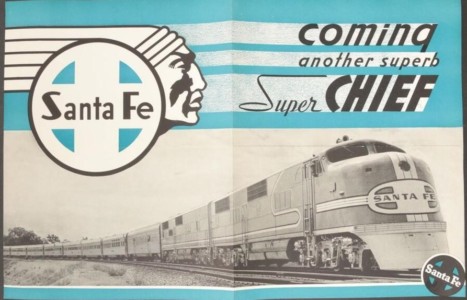 Unlike other railroad collectibles, most railroad paper was never meant to have long-term durability. Railroads mass produced thousands of “giveaway” paper items on which they prominently advertised their name and logo. Eager to advertise their route, the railroads issued this paper to the public, to shippers, or to investors for one time use or seasonal use. Railroads were not concerned whether tourists retained these “giveaways” but assumed the recipients would throw them away.
Unlike other railroad collectibles, most railroad paper was never meant to have long-term durability. Railroads mass produced thousands of “giveaway” paper items on which they prominently advertised their name and logo. Eager to advertise their route, the railroads issued this paper to the public, to shippers, or to investors for one time use or seasonal use. Railroads were not concerned whether tourists retained these “giveaways” but assumed the recipients would throw them away.
However,19th and early 20th century railroad paper often displayed exquisite artwork on their covers. This paper, along with other souvenir items, passengers did not throw away but brought back into their homes and treasured. From the 1900s until the late 1940s, railroads were the primary carrier for most traveling tourists. The increases in tourist travel encouraged railroads to produce more paper items that exhibited exciting new images to attract the tourist to their route.
The following listing is not all inclusive but a sampling of the variety of this desirable collectible.
From the Depot to the Train
The traveling public began their journey at their local depot. There they could pick up various travel information which aided them in planning their trip.
 PUBLIC TIMETABLES were important for tourists to obtain accurate information on when their train would arrive at their depot. Early timetables also included information on fares, sleeping coaches, steamship connections, hotels, and sights along the route. To make timetables easy to store, railroad designed the majority as either a booklet or a foldout. However, railroads also had a need to advertise special trains or excursions which their current timetable would not have listed. Railroads had to design an updated version of the timetable and it was essential that these new timetables drew public attention. Railroads chose to use paper that was single-sided and larger in size. These larger versions of timetables, a broadside, advertised specific dates, specific stations where departures/arrivals would occur and sometimes, included the cost of the fare. Timetables that are scarce and in excellent condition are highly collectible.
PUBLIC TIMETABLES were important for tourists to obtain accurate information on when their train would arrive at their depot. Early timetables also included information on fares, sleeping coaches, steamship connections, hotels, and sights along the route. To make timetables easy to store, railroad designed the majority as either a booklet or a foldout. However, railroads also had a need to advertise special trains or excursions which their current timetable would not have listed. Railroads had to design an updated version of the timetable and it was essential that these new timetables drew public attention. Railroads chose to use paper that was single-sided and larger in size. These larger versions of timetables, a broadside, advertised specific dates, specific stations where departures/arrivals would occur and sometimes, included the cost of the fare. Timetables that are scarce and in excellent condition are highly collectible.
SYSTEM MAPS gave both the traveling public and freight shippers a “bird’s eye view” of a railroad’s route within the United States. When folded, the passenger maps looked much like a timetable. When unfolded, these early maps would display the road’s great looking logo/name and show various destinations and connecting routes throughout the region it served. The map’s back side would have specific information, sometime financial, about the railroad. For shippers, the railroads produced much larger wall maps which rolled down. These maps were linen backed and sometimes had great lithographs displayed around the side borders. Railroads gave these maps to freight shippers and investors. Early maps in good condition are highly collectible.
TICKETS & TICKET HOLDERS were available at the depot and purchased by passengers before boarding the train. Tickets varied not only in size, but in the amount of printed information. Early tickets often only stated the railroad’s name, where passengers boarded, and destination. Other tickets may have shown the cost of the fare or various rules such as “nontransferable.” Sometimes, the ticket included a small envelope. Throughout the 20th century, most railroads began using a larger and more colorful ticket holder to advertise their name trains or logo brands. For a brief time in the 1930s, a couple of railroads did away with separate holders. Instead, the construction of the holder placed longer and more informative tickets between two pieces of heavy cardstock then stapled them all together. The cardstock boldly advertised the railroad’s name on both the front and back of the holder. Early tickets and holders in good condition are very collectible.
 MENUS highlighted a railroad’s ability to provide fine cuisine to the passenger. In the 19th century, menu covers were beautifully illustrated and the entrée offerings, such as oysters, ox tongue, or caviar, indicated that their usual patron was more affluent. By the early 20th century, railroads sought to increase passenger use of their dining car. This led to the deletion of the more exotic items and replacement with more economically priced entrees. Railroads never missed an opportunity to advertise, and a beautifully designed menu cover was an excellent way to highlight their road. The majority of menu covers used exciting imagery of a name train, or beautiful scenes of well-known destinations which they served. Other types of menus had a specific purpose. One menu allowed a passenger to write a small letter back to family and friends. This menu, a great advertising ploy, retained both its colorful cover and entrée listing, but then, passengers were able to fold, stamp and give it to the steward for mailing. Children’s menus were immensely popular. Often designed as an animal cut out, these menus catered to the small traveler’s sense of fun and taste. Groups that chartered special trains had menus which prominently displayed the organization’s name and the group’s destination. These menus were sometime a single page and did not list entrée prices since tour fares were all inclusive. Single page menus were an efficient way to highlight special course offerings or coffee shop light fare. Later, railroads often used single sided menus as a cost saving alternative to the earlier more elaborately designed menus. Early and scarce menus in good condition are highly collectible
MENUS highlighted a railroad’s ability to provide fine cuisine to the passenger. In the 19th century, menu covers were beautifully illustrated and the entrée offerings, such as oysters, ox tongue, or caviar, indicated that their usual patron was more affluent. By the early 20th century, railroads sought to increase passenger use of their dining car. This led to the deletion of the more exotic items and replacement with more economically priced entrees. Railroads never missed an opportunity to advertise, and a beautifully designed menu cover was an excellent way to highlight their road. The majority of menu covers used exciting imagery of a name train, or beautiful scenes of well-known destinations which they served. Other types of menus had a specific purpose. One menu allowed a passenger to write a small letter back to family and friends. This menu, a great advertising ploy, retained both its colorful cover and entrée listing, but then, passengers were able to fold, stamp and give it to the steward for mailing. Children’s menus were immensely popular. Often designed as an animal cut out, these menus catered to the small traveler’s sense of fun and taste. Groups that chartered special trains had menus which prominently displayed the organization’s name and the group’s destination. These menus were sometime a single page and did not list entrée prices since tour fares were all inclusive. Single page menus were an efficient way to highlight special course offerings or coffee shop light fare. Later, railroads often used single sided menus as a cost saving alternative to the earlier more elaborately designed menus. Early and scarce menus in good condition are highly collectible
PLAYING CARDS gave the railroads another great advertising opportunity to show off their logos, their trains, and their scenic routes. Unlike timetables or brochures, playing cards were durable and the railroad expected the passenger to take the deck home and use it when playing cards with family or friends. Railroads both gave and sold playing cards to passengers. The early single decks came in a wide sized version and included extra cards such as two jokers and a substantial slipcover. By the 1920s, the more common, narrow deck became the standard playing cards used. These single decks had softer slipcovers and included extra cards such as jokers or a calendar card. Double decks were also available for purchase. Early and scarce playing cards in good condition are very collectible.
 CIGAR BOXES brimming with cigars was an item that railroads understood 19th century male passengers would require. Found in smoking cars, these cigar boxes were another opportunity to advertise the railroad’s name, logo, and sometimes a train image. The boxes, constructed of wood, had the railroad’s labels applied to the top and back of the lid. The cigar labels displayed vibrant colors through a printing process called chromolithography. Throughout the 20th century, cigar boxes were available in a railroad’s smoking lounge. Early cigar boxes in good condition are rare and collectible.
CIGAR BOXES brimming with cigars was an item that railroads understood 19th century male passengers would require. Found in smoking cars, these cigar boxes were another opportunity to advertise the railroad’s name, logo, and sometimes a train image. The boxes, constructed of wood, had the railroad’s labels applied to the top and back of the lid. The cigar labels displayed vibrant colors through a printing process called chromolithography. Throughout the 20th century, cigar boxes were available in a railroad’s smoking lounge. Early cigar boxes in good condition are rare and collectible.
 MATCHBOOKS were yet another railroad mass produced giveaway to passengers and freight shippers. Match covers reinforced the same advertising themes which the railroad had used before. The passenger had to be able to recognize the brand, therefore the use of bold print was needed for name and logo. Artwork showing a racing train gave both passenger and shipper the imagery of quick arrival or delivery. Depiction of recreational destinations had to tempt a passenger to book another trip. Match covers are abundant, inexpensive, and fun to collect.
MATCHBOOKS were yet another railroad mass produced giveaway to passengers and freight shippers. Match covers reinforced the same advertising themes which the railroad had used before. The passenger had to be able to recognize the brand, therefore the use of bold print was needed for name and logo. Artwork showing a racing train gave both passenger and shipper the imagery of quick arrival or delivery. Depiction of recreational destinations had to tempt a passenger to book another trip. Match covers are abundant, inexpensive, and fun to collect.
Industry to Employee
Many paper railroad items were issued for use by employees on-the-job. Trainmen, depot, and office employees utilized rule books, timetables, passes, company letterhead, envelopes, and other stationary items. These workday items have become collectibles. The railroad industry also published railroad magazines for the employees and issued stocks and bonds during business. Early railroads even issued their own currency.
PASSES were issued by the railroads to railroad officials, employees and their families, journalists, politicians, clergy and others. Other carriers such as express companies, omnibus lines and the Pullman Company also issued passes. Passes can be annual or good for one trip only. Earlier passes that picture a locomotive, passenger train, picturesque scene, ornate design, and fancy lettering are very desirable as are those from small defunct railroads.
EMPLOYEE TIMETABLES were issued to provide information on the daily operations of trains. Due to their utilitarian use, they generally are plain looking compared to their passenger timetable counterparts. They can be in booklet or folder type formats. Although employees were instructed to destroy copies once an update was issued, many survived and have found their way into the hands of collectors. They provide information to the collector on train times, operating days, stops, and sometimes equipment.
RULE BOOKS were issued to employees concerning railroad operations. They were expected to be followed to the letter. Those who did not follow the rules were subject to disciplinary action up to and including termination.
A great number of railroad magazines were published for employees. Individual railroads would publish their own railway employee magazines. Also, brotherhoods, such as Brotherhood of Locomotive Engineers, Brotherhood of Locomotive Fireman, etc. published journals.
Railroads provided stationery including letterhead, envelopes, scratch pads and memo pads for official railroad use which often included the railroad logo, etc.
RAILROAD STOCKS and BONDS are often ornate and may feature a locomotive. Older certificates are typically quite ornate. In the early days of railroads, some railroads even issued their own currency.
Enticing Advertising to Treasured Souvenirs
All railroads were in competition with each other for not only freight shippers but for the traveling tourists. The big question was how they could distinguish themselves from their competitors. Wall maps might convince the freight shippers to use their route, but the traveling tourists required a different approach. To have the tourist even consider boarding the train, railroads would have to develop a variety of advertising solutions.
 WALL POSTERS were a visual entry way for tourists to imagine seeing themselves traveling to a national park, attending a world fair, or visiting the west coast. However, they were not the first choice of 19th century railroads. Instead, railroads commissioned well known painters to produce canvases depicting grand sights that a passenger would view on “their route.” The railroads exhibited these paintings in public buildings throughout the nation. Unfortunately, there were too few paintings and too few potential tourists who visited the exhibits. It is then railroads turned to wall posters for its greater distribution potential. Early wall posters were colorful lithographs but by the 20th century the less expensive process of offset printing became the norm. To attain the most compelling image, railroads commissioned well known artists and then the posters were widely distributed to public spaces such as depots, hotels, and travel agencies. These posters helped the tourist to associate regions of the country with specific railroads. Early and scarce posters in good condition are highly collectible.
WALL POSTERS were a visual entry way for tourists to imagine seeing themselves traveling to a national park, attending a world fair, or visiting the west coast. However, they were not the first choice of 19th century railroads. Instead, railroads commissioned well known painters to produce canvases depicting grand sights that a passenger would view on “their route.” The railroads exhibited these paintings in public buildings throughout the nation. Unfortunately, there were too few paintings and too few potential tourists who visited the exhibits. It is then railroads turned to wall posters for its greater distribution potential. Early wall posters were colorful lithographs but by the 20th century the less expensive process of offset printing became the norm. To attain the most compelling image, railroads commissioned well known artists and then the posters were widely distributed to public spaces such as depots, hotels, and travel agencies. These posters helped the tourist to associate regions of the country with specific railroads. Early and scarce posters in good condition are highly collectible.
PRINTS/PHOTOGRAPHY/STEREO CARDS promoted not only passenger travel but to attract new investors, retain existing shareholders, and encourage settlement along their route. As early as the mid-19th century, wood prints depicted various scenes such as a train passing through a flood plain, shooting buffalo from a train, or an accident on a bridge. By the 20th century, railroads were reproducing colorful lithographic prints of locomotives, depots, and landmarks on the route. Railroads first used photography as a tool to document important achievements such as the building and completion of first transcontinental railroad. From then on, railroads continued to commission well known photographers to produce beautiful images that depicted the route’s highlights. Stereo cards, usually sold in a set, were sold to traveling tourists as a memento of the trip. The stereo card could show an image of a train, camp scenes, Native Americans, track construction by Chinese immigrants. Early photographs by well-known photographers are highly collectible.
BROCHURES/GUIDES gave a full description of what a tourist might see from the “passenger car window.” Like timetables, these early publications used great cover graphics and again like wall posters associated a specific region to a specific road. Inside, the guide described the towns, landmarks, and scenery located on the route. Often, there were charming illustrations or photos to aid in the description of the journey. Brochures were available at most tourist locations and if requested, a railroad mailed directly to the interested party. Early and scarce brochures in good condition are very collectible
 CALENDARS were another excellent opportunity for railroads to promote themselves. Distribution of calendars that exhibited vivid imagery and were issued free to the public, ensured their brand would be viewed in a home for at least a year. In the late 19th century, a calendar’s format used a string to hold its pages together. Most calendars held a full 12 months, but others held 6 months or displayed 12 months on four sheets. By the 1920s, the usual calendar design was to staple a 12-month pad to a larger sheet, however, a monthly single sheet was an exception that was used. Certain railroads reproduced images of paintings by famous artists such as Winhold Reiss, E.I. Couse, Gustav Krollmann to portray their route. Other railroads commissioned a commercial artist such as Leslie Ragan who specialized in depicting racing locomotives or Grif Teller who highlighted both passenger and freight service traveling throughout railroad’s route. In World War II, Dean Cornwell created, stirring patriotic imagery of a railroad’s linkage to the war effort. Due to cost saving measures, railroads gradually moved to eliminate calendars from their budgets. Scarce calendars in good condition are highly collectible
CALENDARS were another excellent opportunity for railroads to promote themselves. Distribution of calendars that exhibited vivid imagery and were issued free to the public, ensured their brand would be viewed in a home for at least a year. In the late 19th century, a calendar’s format used a string to hold its pages together. Most calendars held a full 12 months, but others held 6 months or displayed 12 months on four sheets. By the 1920s, the usual calendar design was to staple a 12-month pad to a larger sheet, however, a monthly single sheet was an exception that was used. Certain railroads reproduced images of paintings by famous artists such as Winhold Reiss, E.I. Couse, Gustav Krollmann to portray their route. Other railroads commissioned a commercial artist such as Leslie Ragan who specialized in depicting racing locomotives or Grif Teller who highlighted both passenger and freight service traveling throughout railroad’s route. In World War II, Dean Cornwell created, stirring patriotic imagery of a railroad’s linkage to the war effort. Due to cost saving measures, railroads gradually moved to eliminate calendars from their budgets. Scarce calendars in good condition are highly collectible
 INK BLOTTERS were another inexpensive way for railroads to promote their route to freight shippers and traveling tourists. Rarely used today, an ink blotter was a necessity in the 19th and early 20th centuries. Unlike a ball point pen, fountain pens often left excessive ink on the paper and if not blotted, the ink could smear. Early railroad blotters could be very colorful and often displayed a name train’s route and schedule. Blotters are a fun and less expensive collectible.
INK BLOTTERS were another inexpensive way for railroads to promote their route to freight shippers and traveling tourists. Rarely used today, an ink blotter was a necessity in the 19th and early 20th centuries. Unlike a ball point pen, fountain pens often left excessive ink on the paper and if not blotted, the ink could smear. Early railroad blotters could be very colorful and often displayed a name train’s route and schedule. Blotters are a fun and less expensive collectible.
 LUGGAGE LABELS/STICKERS, first used by ocean liners, were a terrific advertising opportunity that railroads quickly copied. These colorful labels usually depicted the image of name train and sometimes had a space for the passenger’s name and address. Affixed with gum, passengers then placed the label on their luggage. As a memento of their trip, passengers sometimes requested an extra label. Luggage labels are a fun and less expensive collectible.
LUGGAGE LABELS/STICKERS, first used by ocean liners, were a terrific advertising opportunity that railroads quickly copied. These colorful labels usually depicted the image of name train and sometimes had a space for the passenger’s name and address. Affixed with gum, passengers then placed the label on their luggage. As a memento of their trip, passengers sometimes requested an extra label. Luggage labels are a fun and less expensive collectible.
POSTER STAMPS, sometimes called Cinderellas, resembled miniature posters printed on sheets, gummed, and then perforated. Resembling postal stamps, they had no postal value, but the stamps’ purpose was to promote a railroad’s route through a series of vivid imagery. As with matchbooks, poster stamps were cost-efficient, and widely distributed throughout the nation by affixing them to envelopes, letters, invoices, and packages. From the 1920s through the 1940s, the traveling public used and collected poster stamps. Poster stamps are a fun and less expensive collectible.
 HAND FANS, used by the railroads as early as the 1880s, were one more promotional opportunity to advertise the route. There were three distinct types of hand fans. An early fan, which was designed and manufactured in Osaka, Japan, used Japanese paper on a bamboo frame that included the handle. This railroad chose a Japanese design on front and on the backside had their route map and logo. This railroad was promoting their service as a conduit for commodity exchange with Asia. Another fan construction was the traditional folding fan. These fans mounted paper on slats which revolved around a pivot for easy closure and storage. One railroad designed this fan to advertise their bold logo on front and their steamship on the backside. The last popular fan format was to use simple cardstock and staple it onto a wood handle. Advances in printing enabled these types of fans to be mass produced, use a colorful image or photograph on the front side, and promotional info on the backside. By the 1930s, hand fans began to lose popularity and most railroads had discontinued their production by the late 1940s. Early hand fans in good condition are scarce and collectible.
HAND FANS, used by the railroads as early as the 1880s, were one more promotional opportunity to advertise the route. There were three distinct types of hand fans. An early fan, which was designed and manufactured in Osaka, Japan, used Japanese paper on a bamboo frame that included the handle. This railroad chose a Japanese design on front and on the backside had their route map and logo. This railroad was promoting their service as a conduit for commodity exchange with Asia. Another fan construction was the traditional folding fan. These fans mounted paper on slats which revolved around a pivot for easy closure and storage. One railroad designed this fan to advertise their bold logo on front and their steamship on the backside. The last popular fan format was to use simple cardstock and staple it onto a wood handle. Advances in printing enabled these types of fans to be mass produced, use a colorful image or photograph on the front side, and promotional info on the backside. By the 1930s, hand fans began to lose popularity and most railroads had discontinued their production by the late 1940s. Early hand fans in good condition are scarce and collectible.
BOOKS/GUIDES, which may have found their way into the 19th century tourist’s home library, may have included the “Travelers Official Rail Way Guide of United States and Canada.” The “Official Guide,” initially published monthly, enumerated the railroads’ operating structure such as system maps, timetables, passenger service, mileage between stations and more. Two books published annually and used as reference guides for investors, were the “Poor’s Manual of Railroads of the United States” and “Moody’s Steam Railroads.” Each of these publications reported railroads financial earnings, listed railroad’s officers, inventoried equipment, reviewed historical data, and included maps. Other categories included technical books like Roper’s “Hand-Book of the Locomotive” or works of fiction like Horatio Alger’s “The Erie Train Boy.” Early reference books in good condition are very collectible.
SHEET MUSIC, which celebrated either a specific railroad or generic railroad themes, began to be published in the 19th century. Two 1828 songwriters, who eagerly anticipated the building of the Baltimore and Ohio Railroad, wrote songs to commemorate that future action entitled “The Carrolton March” and the “Rail Road March.” Other specific railroad songs were the 1853 “Fast Line Gallop” dedicated to the Pennsylvania Central RR or the 1859 “North Western Railway Polka dedicated to the Chicago and North Western Railway. Railroads sometimes published sheet music to promote a new train. In 1897, the Atchison, Topeka, and Santa Fe Railroad, published the “Queen of the Santa Fe” or the Kansas City Southern Railway’s 1940 “Southern Belle.” By the late 1920s, techniques in audio recording had advanced. This development led to a steep decline in sheet music sales. Early sheet music covers have wonderful graphics and are collectible.
 POSTCARDS, in the early 20th century, became a popular form of written correspondence. Tourists favored postcards because they showed an image of the attractions they were seeing and only required a brief written note of description. Railroads were happy to employ another inexpensive tool to promote their route and produced postcards which highlighted their locomotives, depots, passenger car interiors, and scenic landmarks. Railroads, beginning in the mid-19th century, had earned revenue from US Post Office to quickly carry mail. These railroads had a rolling Railway Post Office (RPO) designated car where postal clerks separated mail for distribution to a west or east connection. Post cards that carried an RPO rubber stamp were desired. Railroad postcards have become an excellent method to historically document what once existed and are a fun and often an inexpensive collectible.
POSTCARDS, in the early 20th century, became a popular form of written correspondence. Tourists favored postcards because they showed an image of the attractions they were seeing and only required a brief written note of description. Railroads were happy to employ another inexpensive tool to promote their route and produced postcards which highlighted their locomotives, depots, passenger car interiors, and scenic landmarks. Railroads, beginning in the mid-19th century, had earned revenue from US Post Office to quickly carry mail. These railroads had a rolling Railway Post Office (RPO) designated car where postal clerks separated mail for distribution to a west or east connection. Post cards that carried an RPO rubber stamp were desired. Railroad postcards have become an excellent method to historically document what once existed and are a fun and often an inexpensive collectible.
Railroad paper is wonderfully diverse and can tempt every railroad collector. For the advanced collector, there is always that elusive piece which is missing from the collection. For the beginning collector, there is plethora of items to choose from which will not “not break the bank.”
Gallery

